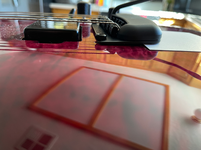jesyjames
New member
I have quite a bit of experience with acoustic guitars, but much more limited experience in the electric world. I've been looking to get more into it and picked up a Sabre HT and overall am thrilled with the guitar.
However, I am experiencing some extreme fret buzz on the low E and A strings. Out of the box: they buzz open(if picked with an oomph), fretted, and all along the neck.
Things I've tried: I've adjusted the truss rod, I've adjusted the bridge saddle with the two hex screws(tightening and loosening) to try and adjust the string height, and I've adjusted the spring tension on the back of the guitar to also try and adjust the bridge height.
As far as I can tell there is no way to adjust the individual string height correct? I can tilt the bridge using the tremelo but I didn't see any individual adjustments.
What happens if I fix the buzz in one place it just moves somewhere else along the fretboard. No issues at all with the other 4 strings. I can mostly eliminate the buzzing I raise the bridge pickup height, but then it's so high as to not really be an option.
Any tips for a complete electric noob? At this point I feel like all I am doing is moving the problem around and lost my way point of how the guitar was originally set up. At this point I don't know where the bridge was originally set nor the truss rod. Regardless, it had the problem from first strum.
Also, regarding the tremolo-- after installing it, how do I know how much to tighten the spring screws? The FAQ made it
This is the only advice I've found from music man and not even sure it applies to the Sabre:
5. Set the tremolo spring claw
a. From the factory, the tremolo is set to remain flat on the body if a note is bent a full step or less.
b. Bend the G note at the 12th fret to an A, and check if the bridge is lifting.
c. Adjust the spring claw so the bridge begins to lift when this note is bent beyond an A.
6. Double check the setup and enjoy!!
a. If experiencing fret buzz on the first few frets (1~4), the truss rod needs to be loosened. If experiencing buzz in the middle of the neck (frets 6~10) the truss rod needs to be tightened.
b. If experiencing fret buzz across the entire neck, the bridge saddles need to be raised.
Thank you so much for your time! I am so excited to get this setup and really start enjoying it, but now my OCD is killing the enjoyment.
However, I am experiencing some extreme fret buzz on the low E and A strings. Out of the box: they buzz open(if picked with an oomph), fretted, and all along the neck.
Things I've tried: I've adjusted the truss rod, I've adjusted the bridge saddle with the two hex screws(tightening and loosening) to try and adjust the string height, and I've adjusted the spring tension on the back of the guitar to also try and adjust the bridge height.
As far as I can tell there is no way to adjust the individual string height correct? I can tilt the bridge using the tremelo but I didn't see any individual adjustments.
What happens if I fix the buzz in one place it just moves somewhere else along the fretboard. No issues at all with the other 4 strings. I can mostly eliminate the buzzing I raise the bridge pickup height, but then it's so high as to not really be an option.
Any tips for a complete electric noob? At this point I feel like all I am doing is moving the problem around and lost my way point of how the guitar was originally set up. At this point I don't know where the bridge was originally set nor the truss rod. Regardless, it had the problem from first strum.
Also, regarding the tremolo-- after installing it, how do I know how much to tighten the spring screws? The FAQ made it
This is the only advice I've found from music man and not even sure it applies to the Sabre:
5. Set the tremolo spring claw
a. From the factory, the tremolo is set to remain flat on the body if a note is bent a full step or less.
b. Bend the G note at the 12th fret to an A, and check if the bridge is lifting.
c. Adjust the spring claw so the bridge begins to lift when this note is bent beyond an A.
6. Double check the setup and enjoy!!
a. If experiencing fret buzz on the first few frets (1~4), the truss rod needs to be loosened. If experiencing buzz in the middle of the neck (frets 6~10) the truss rod needs to be tightened.
b. If experiencing fret buzz across the entire neck, the bridge saddles need to be raised.
Thank you so much for your time! I am so excited to get this setup and really start enjoying it, but now my OCD is killing the enjoyment.




